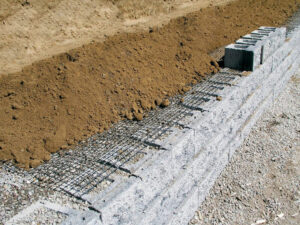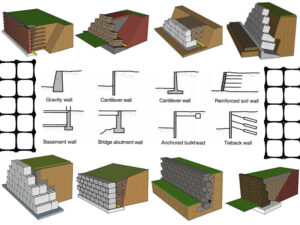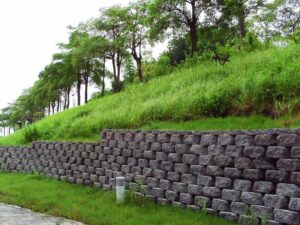Geotextile Used For Silt Fence, Gabion Wall, Septic, Cattle & Horse Arena
Geotextiles play a crucial role in projects such as Silt Fence, Gabion Wall, Septic, Cattle & Horse Arena.
In silt fence projects, geotextile fabric is used to wrap silt or other loose materials, preventing them from spreading into the surrounding environment. The geotextile’s permeability allows water to drain while maintaining the stability of the silt, preventing it from being washed away or contaminating nearby water bodies. Non-woven geotextiles, with their excellent filtration properties, are commonly used in these types of projects.
In the construction of septic systems, geotextile fabrics are typically used for lining and protection, preventing soil and groundwater contamination. They act as a barrier between the septic tank and the surrounding soil, stopping waste leakage while allowing normal groundwater flow.
For gabion walls, geotextile cloth is used to separate and reinforce the gabion structure, preventing soil from entering the gabion while ensuring smooth water flow through the wall.
In horse arenas or cattle farms, geotextile fabrics are often laid on the ground to provide a stable foundation, prevent muddiness, and ensure proper drainage. Non-woven membranes are one of the most commonly used materials for such farm applications.
Geotextiles play an indispensable role in these diverse types of projects. Whether it’s preventing environmental damage from silt, stopping waste leakage, or preventing soil erosion, geotextile fabric is essential for project success.
Therefore, if your project involves silt fence, gabion wall, septic, cattle & horse arena, or similar applications, geotextile fabric can be effectively used to meet your needs.
Geotextile Fabric Introduction
Geotextiles are one of the most widely used materials in engineering. Each product has distinct features, functions, and applications. Click the button below to learn more about product information.
Geotextile
Woven Geotextile
Non-Woven Geotextile
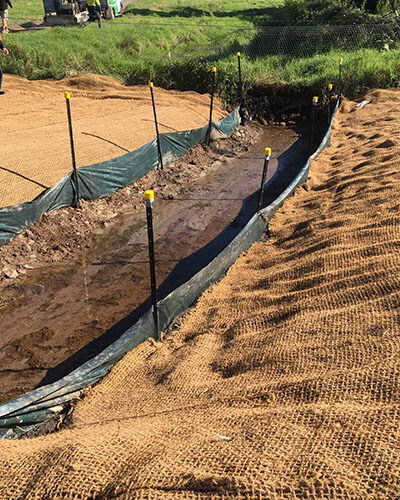
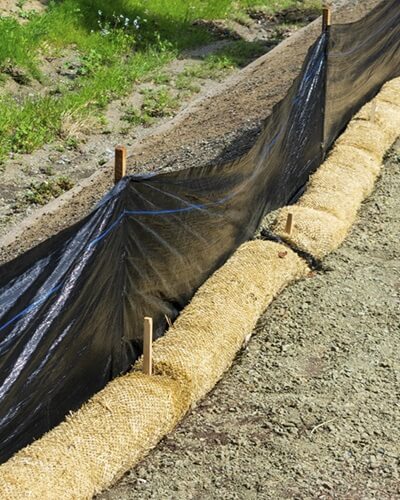
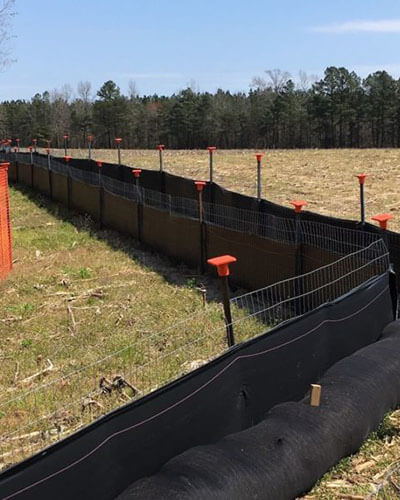
Geotextile Used For Silt Fence
Silt fences are primarily used in river restoration, wetland protection, port construction, and land reclamation projects to control and manage the dispersion and migration of silt.
Due to the instability of silt and its tendency to be transported by water or wind, strong materials are needed to address these challenges.
Geotextiles fabric are one of the best options for this purpose, offering excellent permeability, filtration, strength, durability, and tear resistance, making them ideal for meeting the filtration requirements in silt fence applications. Non-woven geotextiles may provide better filtration, while woven geotextiles offer superior strength and tensile properties.
Geotextile silt fences use their small pore size to effectively filter silt particles, preventing them from being washed away by water. This allows for efficient management of silt, preventing water pollution and protecting aquatic ecosystems. Whether woven or non-woven geotextiles fabric have a long lifespan, maintaining the stability of the silt fence for years and resisting environmental erosion and pressure.
Geotextile Used For Gabion Wall
Gabion walls are primarily used for riverbank protection, dam stabilization, slope protection, and landscaping projects. By filling them with stones or gravel, gabion walls create a permeable, erosion-resistant structure.
In the construction of gabion walls, geotextiles are used to prevent soil particles from being washed through the gabion structure, as gabion walls are usually in direct contact with the soil. Geotextile filter fabric effectively addresses this issue.
Geotextiles filter cloth have extremely small pores that allow water to flow freely while blocking fine soil particles from entering the gabion structure, preventing clogging by sediment. Additionally, the geotextile’s separation function helps isolate the gabion from the surrounding soil, preventing the mixing of the internal stones with external soil, thereby maintaining the structural stability of the gabion wall. This is particularly important in areas with heavy rainfall or along riverbanks with strong water flow, where the powerful filtration capability of geotextiles effectively protects the soil from being eroded by water, reducing the risk of soil erosion.
By preventing soil loss, geotextiles enhance the overall stability of gabion walls, improving their resistance to erosion and slippage. Over long-term use, geotextiles also help minimize disturbance to the natural soil, ensuring protection against soil erosion while preserving the surrounding ecosystem.
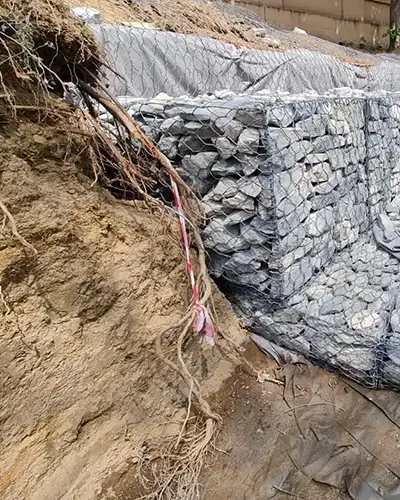
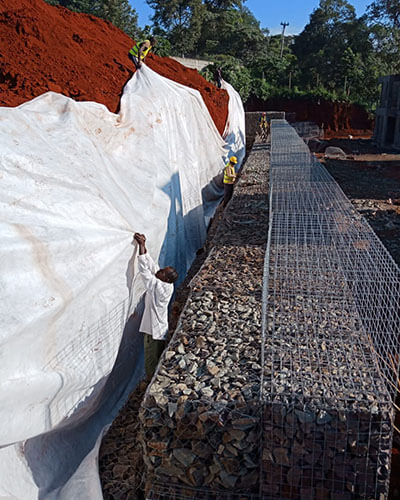
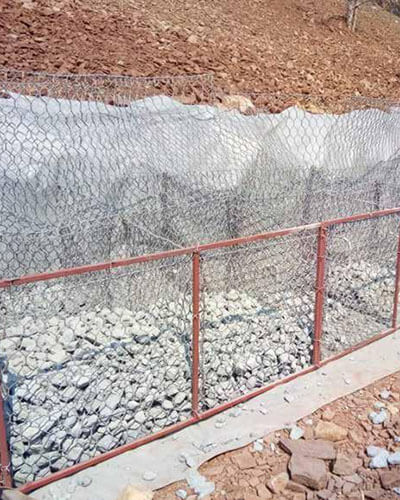
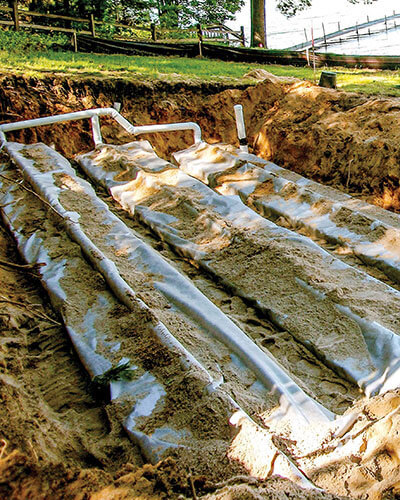
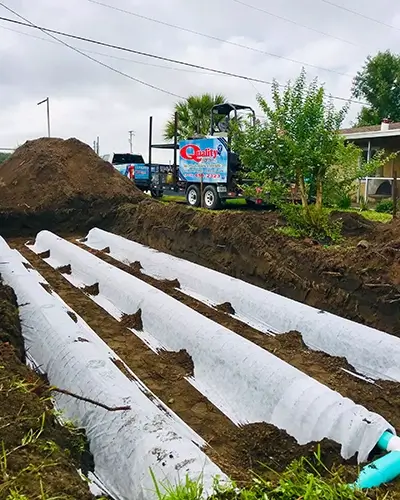
Geotextile Used For Septic Systems
Septic systems are primarily used to capture and treat household wastewater by separating solid waste, breaking it down, and allowing pollutants in the water to settle, thereby reducing direct environmental pollution from sewage.
In a septic system, geotextile filter fabric plays a key role in filtration and separation. Once solid waste settles at the bottom of the septic tank, the liquid/wastewater flows through pipes into perforated pipes and then seeps into the ground. These perforated pipes are typically wrapped in gravel, and the geotextile is used to wrap the gravel. The main purpose of the geotextile is to separate the soil from the gravel, preventing soil particles from infiltrating while filtering out fine particles from the outgoing liquid/wastewater, thus preventing environmental contamination.
The permeability, tensile strength, durability, and resistance to chemical corrosion of geotextiles ensure their long-term functionality in septic systems, especially in wet and highly corrosive environments.
Geotextile Used For Horse/Cattle Arena
Horse and cattle arena typically have large areas with frequent activity from both humans and livestock, which can lead to loose and muddy soil, affecting livestock movement and health. This problem is especially pronounced in rainy areas, where surface water and mud accumulation are significant issues.
Using geotextiles fabric in such areas can effectively improve ground conditions by providing a more stable, dry surface, reducing mud and water accumulation, and extending the lifespan of the area while promoting the health of the livestock.
In horse and cattle arena, geotextiles fabric primarily serve three purposes:
1. Ground Stability: By laying geotextiles fabric, soil loosening and subsidence can be effectively prevented, improving the stability of the ground, especially in areas with frequent livestock activity.
2. Drainage and Mud Prevention: Geotextiles fabric have excellent drainage and permeability, allowing excess surface water to drain away, reducing water accumulation and preventing the formation of mud, keeping the area dry.
3. Erosion Prevention: In cases of heavy rain or frequent livestock trampling, geotextiles fabric help prevent soil erosion and loss, ensuring the ground structure remains intact and undamaged.
Geotextiles offer strong performance in terms of tensile strength, abrasion resistance, durability, and permeability. Non-woven membrane are typically used in areas that require good permeability and filtration, while woven geotextiles are chosen for areas needing higher strength and abrasion resistance. In farm construction projects like horse and cattle farms, non-woven membrane are more commonly used due to their superior water permeability and filtration capabilities.
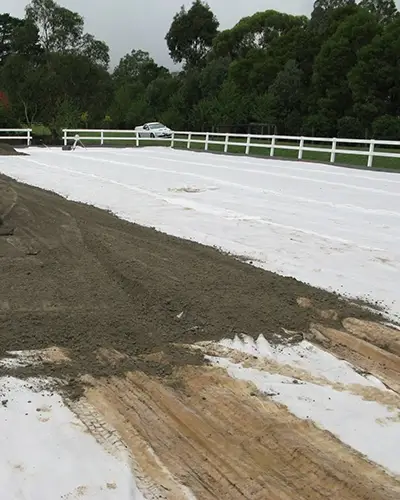
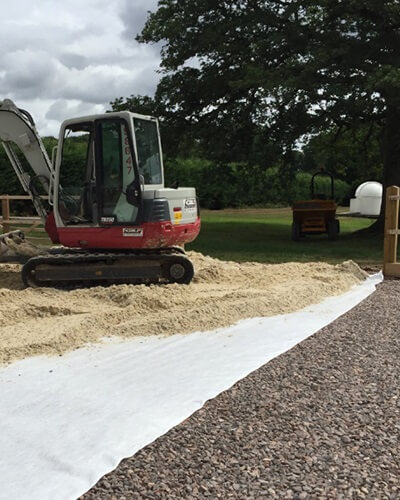
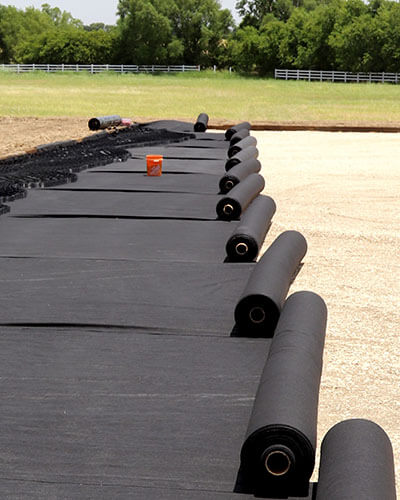
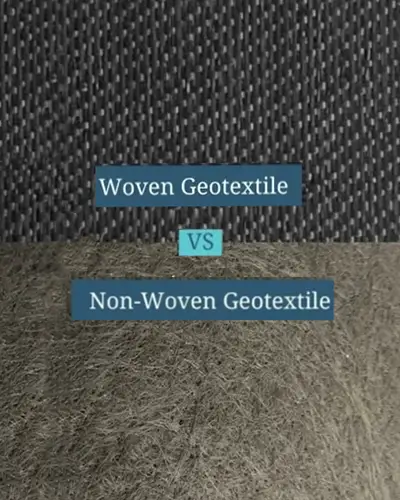
Choose Which Geotextile to Use for Silt Fence, Gabion Wall, Septic, Horse Arena, Cattle Farm
As we know, geotextile fabrics are mainly divided into two types: non-woven and woven.
For different application scenarios, such as silt fences, gabion walls, septic tanks, horse arenas, and cattle farms, the choice must be made by considering the specific project needs, environmental conditions, and the performance characteristics of the geotextiles.
Performance Characteristics of Geotextiles:
Non-woven geotextile fabrics are typically used in situations requiring high permeability and filtration.
Woven geotextile fabric is better suited for projects that demand higher tensile strength and abrasion resistance.
Project Needs:
Silt fences, septic tank systems, horse arenas, and cattle farms require materials with good filtration and permeability.
Gabion walls, on the other hand, require materials with higher tensile strength and puncture resistance.
Environmental Conditions:
Exposure to corrosive elements such as water, waste, and silt.
Intense exposure to natural sunlight.
Conclusion:
Non-woven geotextiles are more suitable for applications like silt fences, septic tanks, horse arenas, and cattle farms due to their filtration and permeability capabilities.
Woven geotextiles are recommended for gabion walls where higher tensile strength and puncture resistance are crucial.
However, many projects might not rely on a single type of material.
For example:
In horse farms and cattle farms, areas with higher demands for abrasion resistance and tensile strength, such as zones with intense livestock activity, woven geotextile cloth can be used to ensure long-term ground stability. Meanwhile, non-woven geotextile cloth can be used in drainage systems (such as drainage ditches and interception ditches) to enhance filtration and water management.
In gabion walls, woven geotextile cloth provides sufficient structural support and prevents soil erosion. However, in situations where higher permeability and filtration are required, a high-strength non-woven geotextile cloth could also be an option.
Recent Projects
Discover our recent client projects and explore the range of tailored, personalized support we provide. Share your requirements and receive the ideal solution.
Recent Company News
Explore our newest releases, stay informed with industry updates on geosynthetics & geocomposite, and delve into technical insights about geotechnical products. For any queries, reach out to us for customized assistance.
Frequently Asked Questions
First, clarify the most basic project requirements and understand the characteristics of geotextiles.
Non-woven geotextiles are usually used in situations that require high permeability and filtration, while woven geotextiles are suitable for applications that require higher strength and wear resistance.
Then, according to the needs of the project, choose a geotextile with high filtration or more wear resistance.
You can check out the “Choose Which Geotextile to Use for Silt Fence, Gabion Wall, Septic, Horse Arena, Cattle Farm” section above.
Tensile strength determines whether the geotextile can maintain structural integrity during construction and use, while durability is related to whether the geotextile will age or fail quickly in harsh environments (such as long-term exposure to water, chemicals or sunlight).
The quality of geotextiles manufactured by QVIOC is unquestionable and fully complies with ASTM and ISO testing standards.
For handling the seams and connections of geotextiles, the following methods can be used.
For seams and connections, overlapping, sewing, welding and other methods can be used. The splicing welding width should generally be greater than 0.1m, and the overlapping width should be greater than 0.2m. Drainage fabrics exposed for a long time should be welded or sewn.
Use a hot air gun to bond the overlapping parts of two geotextiles, ensuring that there is appropriate spacing between the bonding points. When sewing the overlapping parts, use materials that are resistant to chemical damage and UV exposure. Keep the stitches straight and even.
Thickness is one of the important parameters of geotextile, which determines its filtration performance and durability. Generally speaking, the thicker the geotextile, the better the filtration performance and the stronger the durability.
Gram weight refers to the mass of geotextile per square meter, which determines the thickness and weight of geotextile. Generally speaking, the higher the grammage of geotextile, the better its filtration performance, and also the better wear resistance and tensile properties.
Many high-latitude areas in Europe and Asia are under the climatic conditions of the subtropical high pressure in the western Pacific Ocean. The circulation field here is also very strong and the climate is relatively hot. Under such climatic conditions, the aging speed of geotextiles will be much faster than that in low-latitude areas. Even if the cold air in autumn and winter is weak, it still cannot significantly slow down the aging speed of geotextiles.
In low- and mid-latitude areas, due to more rainfall and lower temperatures, the aging speed of geotextile fibers is significantly reduced. Under tests in different ultraviolet bands, the aging speed is significantly accelerated, which also shows that light intensity and precipitation will directly affect the use effect of geotextiles.

